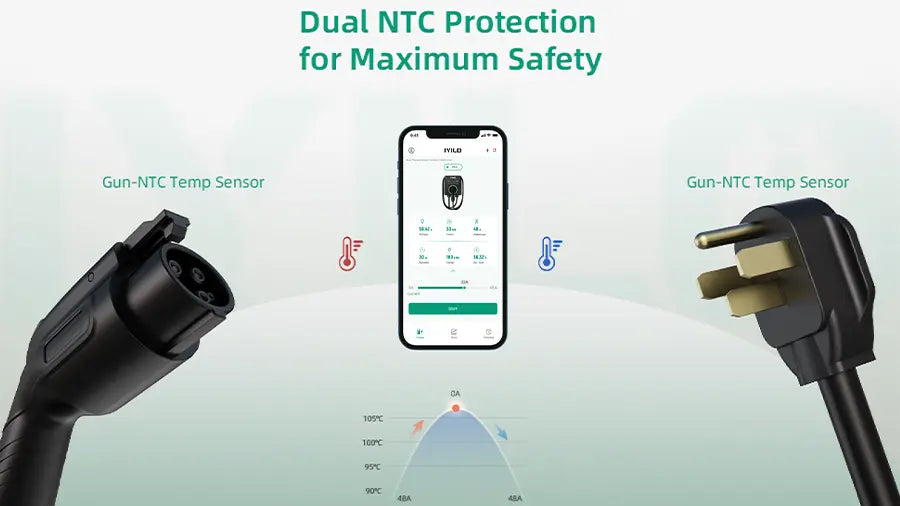NTC Sensor and How Does It Protect EV Chargers
Nowadays, residential EV chargers have evolved from being just charging devices to becoming multifunctional solutions that meet household demands. Rapid technological development has pushed the EV industry to a new level. Dynamic load management, V2H, and other technologies have completely changed people’s behavior and their perception of this innovation.
The complex functions of EV chargers have brought a new challenge: charging safety, which requires people to pay more attention to how to prevent potential risks associated with operating such high-load devices at home almost every day.
One of those concerns is the risk of fire hazards. An EV charger is a continuous-load device that consumes far more kilowatts than typical home appliances. This is especially concerning since many new EV owners lack sufficient knowledge about EV installation.
What is an NTC Sensor?
An NTC sensor refers to a sensor that uses an NTC thermistor (Negative Temperature Coefficient thermistor) to measure temperature. It is a common type of sensor widely used in all kinds of industrial devices. In terms of EV chargers, it specifically refers to the temperature sensor equipped in the cable connector and plug end.
Here are some severe consequences that can happen in daily life due to improper operation of EV charging equipment. For example, one of the most frequent types of fire accidents occurs when an EV charger is plugged into a regular outlet, which can intermittently lead to the outlet burning down. The consequences can be very serious.
How Can an EV Charger NTC Sensor Prevent Potential Fire Hazards?
The NTC sensor, like most other sensors, takes effect only when the temperature reaches the breakpoint at the plug end or connector end. In most practical situations, we refer to the NEMA plug end. Specifically, when the temperature at the NEMA plug rises, the sensor detects it and signals the EV charger to reduce the amperage or even stop charging once it reaches certain temperature thresholds.
This is one of the most useful safety functions for residential EV chargers. Of course, NTC sensors are also widely used in commercial scenarios. Imagine a customer plugging an EV charger into an ordinary outlet without any knowledge of EV charging. Under high continuous charging, the outlet may loosen its internal wires, leading to short circuits. Fire hazards seem almost inevitable unless preventive measures are in place. In this case, the NTC sensor serves as the last line of defense to protect household safety.
Can the NTC Temperature Sensor Replace the Role of an EV-Rated Outlet?
Although the NTC temperature sensor is highly effective in predicting and preventing potential high-temperature spikes caused by an unqualified outlet, it does not fully guarantee the prevention of fire hazards resulting from poor outlet contact.
To better protect household property, customers should understand the importance of installing an EV-rated outlet. At the same time, with the NTC sensor engaged, the EV charger operates under a safety mode, reducing the risk of unexpected fire hazards or property damage.
Is the IYILO EV Charger Equipped with an NTC Temperature Sensor?
After a year of product refinement, we are about to unveil our latest IYILO Level 2 EV Charger for residential use. Among its outstanding features, the IYILO charger is equipped with NTC sensors in both the plug end and the connector end. This unique feature has raised the safety level of residential EV chargers. Here are a few key points:
1.The IYILO EV charger has a preset program that sets thresholds for the sensor to respond under different temperatures. For example, when the temperature of the NEMA plug reaches 85℃, the NTC sensor signals the charger’s control unit to reduce the current for a period of time. After the temperature returns to normal, the current automatically recovers to its original level.
2.The IYILO EV charger integrates an intelligent control algorithm, allowing the charger to dynamically manage the current or even stop charging in specific situations.
3. App monitoring is another highlight of the IYILO Level 2 EV Charger. You can view the NTC sensor temperature through the app, which dynamically displays temperature changes based on the sensor’s feedback. This feature provides extra reassurance for customers who want real-time safety information.
Conclusion
As one of the key safety functions, NTC sensors play a significant role in preventing unexpected hazards that could potentially damage household appliances. This is especially important for unqualified NEMA outlets, which often cannot handle continuous charging. However, no matter how advanced the technology in EV chargers becomes, installing an EV-rated outlet is still essential. After all, the NTC sensor provides early warning rather than complete prevention.



0 comments